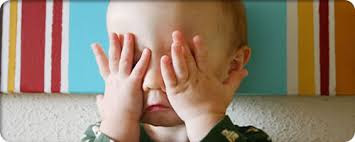Peek-a-Boo, “I Love You”!
Peek-a-Boo is a game that babies and adults
love to play. And if you don’t know already, it teaches great skills and affirms your love for your child! There is nothing a young child would rather see than the face of their parent or care provider.
Covering your face or your baby’s face to ‘hide’ and then
quickly uncovering your face and reappearing accompanied by the words,
“Peek-a-Boo” is a classic baby game. It is simple and can be played with little
or no props, yet teaches important concepts and skills and reinforces the child-parent bond.
When Infants are born, they have no understanding of Object
Permanence. If something disappears from view, in the infant’s mind, it is gone
forever! At this stage of development
(ages 1-4 months) if a child drops a toy off the edge of their highchair, they
do not look for it; if it is totally concealed it ceases to exist for them. At about the age of 4-6 months they begin to realize that just because something is out of
sight, it does not mean that it is gone; if it is partially hidden, they will seek for it.
This is a great age to play Peek-a-Boo, as it reinforces this concept
and brings giggles of delight to young babies.
It is one of the first games they will play. It builds social
interaction, teaches anticipation, and introduces the concept of turn taking. Your baby
quickly learns that they will be ‘surprised’ by the reappearance of your face
and will start looking for you as soon as you are covered.
Older siblings especially love playing with the new baby using this simple game!
Older siblings especially love playing with the new baby using this simple game!
This is an entertaining and
educational activity that requires no preparation or special equipment. Take time to play with the
baby in your life, be it your own, a neighbor’s child, a grandchild, or a child
you babysit. You will be developing
social skills as well as a handful of other great abilities.
Check out our website for great Infant Toys!
Blog Administrator: Trisha Roberts
proeducationaltoys@gmail.com
Copyright © 2016 TNT Inspired Enterprise, LLC, All rights reserved.
Unauthorized duplication is a violation of applicable laws.

































